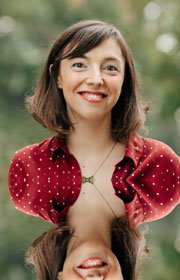My sister and I went through a pretty intense couscous* phase when we were teenagers: my mother kept a kitchen cabinet stocked with little pre-portioned pouches of semoule that barely needed a minute and a half of boiling before we could snip them open, pour their contents into a bowl, add a bit of salt and butter, and call it lunch. We loved the stuff.
I remember suggesting this very menu to Maxence once, early in our relationship, and he looked at me like I had two heads. (Sometimes I think about this, and my former flame for canned beef ravioli, when people ask, “So, were you always interested in cooking?”)
I no longer make whole meals out of plain couscous (see there, on top of my shoulders? only one head!), but I have retained my fondness for the unique mouthfeel it provides, each forkful soft and pillowy before it bursts into a thousand tiny beads that roll around the tongue.
I favor whole wheat couscous now, for reasons of nutrition and taste, and I serve it as an ultra-easy side to stews, Maghrebi in spirit or not. And in the summer, I like to use it as a base for quick, refreshing salads such as this one.
It is inspired by the North African tabouli, better known in France and more ubiquitous at parties than the Lebanese version: couscous-based where its Lebanese cousin involves bulgur (cracked wheat), the North African tabouli also reverses the proportion of white (grains) to green (chopped herbs).
Unless you make your own semolina, hand-rolling, steaming, and sun-drying the grains, which is crazy but admirable, preparing couscous takes ten minutes and approximately zero effort: the store-bought kind is pre-cooked, and only needs plumping in freshly boiled water. You don’t even need to turn on the stove; an electric kettle will suffice.
Other than that, there will be a little herb snipping involved — I like the well-balanced trio of parsley, chives, and mint, but you can pare that down or go wild depending on what you have on hand — and the slicing of a few cherry tomatoes, but that’s about it. Simple, really, and ideal for satisfying lunches, barbecues, and picnics.
Tabouli ordinarily calls for lemon juice, but I find its sharp trill can overwhelm the other flavors, so I prefer to use bottled verjuice — the juice of unripe grapes — as the acidic component.
The tomatoes in tabouli are usually diced from regular-size whole fruits, the juices of which help rehydrate the couscous grains, but cherry tomatoes tend to offer a sweeter and more concentrated tomato flavor that works nicely here, and is accented by a pinch of cinnamon.
[sc:cinnamon_note]
* The term couscous can be used to mean either, 1. a pasta of North African origin made of crushed and steamed Durum wheat semolina, like here, or 2. a North African dish consisting of said pasta, steamed and served with stewed vegetables and grilled meat.
Continue reading »









